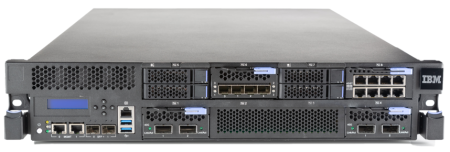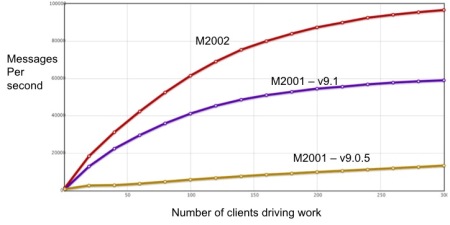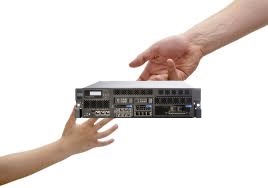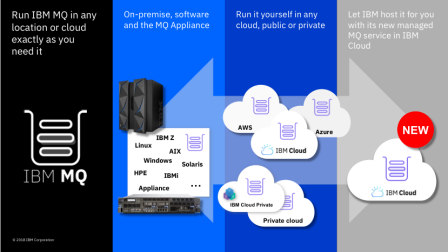
I have already written about the announcement of the new IBM MQ Appliance M2002 which is generally available today (July 27th 2018). It is an amazing bit of kit, and already has demonstrated some staggering performance figures.

But you may well be sitting there reading this going “so what”? Why would I want a physical appliance? Surely this is enterprise middleware software, so I simply build an image, configure it and deploy it on a server, either somewhere inside my enterprise, or in a public cloud. And that is a perfectly valid question. And selecting to deploy software on servers, perhaps in a VM or a container is certainly the typical choice of deployment model these days. And IBM is doing what we can to make that style of deployment easier, simpler and yet more powerful as well. So, given all that, why might you consider and choose a MQ Appliance?
Most importantly, it is a choice. It provides an alternative. One of the benefits of the MQ Appliance as an alternative is that it provides a lot of benefits enabling the use of a very powerful MQ configuration without a number of the costs and burdens that otherwise might be associated with such a deployment. And although it might initially look expensive, it is important not just to realize that the price includes state of the art hardware, but that along with that, there are a multitude of benefits which make the MQ Appliance actually a lower cost alternative to many other software deployment configurations.

Many businesses using MQ have one or more highly skilled MQ administrators, who have, over the course of a number of years, built up a rigorously controlled MQ environment where individual Queue Managers are carefully deployed and managed for significant periods of time. While this is effective, it can also be limiting, as each environment becomes bespoke and dependent on the skills only available in the team and become restrained to the specific deployment environment which is tuned to fit that particular need.
Problems in this type of deployment arise when one of the key resources is no longer available for some reason. There can also be significant disruption at maintenance time, and when moving machines for lifecycle reasons. In the same way it becomes very difficult and time consuming to try and add to the system either to provide additional capacity to the existing applications or to support new applications as the MQ environment is very strong, but not very agile and responsive to change. And one of the problems is that with IT infrastructure, change is continuous. Servers need regular attention, with new OS or firmware patches required, and new hardware needing to be purchased and deployed that is always slightly different to the existing deployed systems.
The MQ Appliance is designed to provide a very strong and resilient MQ environment, primarily for production environments on premises. And it does this without requiring a highly skilled MQ administration team to design, configure, deploy, maintain and operate the MQ environment.
There is no need for what can turn out to be months of optimization and tuning of the MQ environment, as the MQ Appliance gives you optimized Queue Managers out-of-the-box.
There is no need to disrupt operations as an operating system or firmware update is scheduled. With no need to then have another disruption as a separate patch is applied to MQ itself. Instead the MQ Appliance is updated with a single firmware flash, updating all aspects of the appliance including MQ in a matter of minutes.
Unlike with servers where each machine might be different, each generation of MQ Appliances are identical, and will have exactly the same counterpart in IBM itself for development and testing of each firmware update. No more differences between systems. No more ‘install and hope’ that your environment is close enough to the supported environments for that version of MQ. And if the MQ Appliances are defined as a Highly Available pair, then both appliances can be updated to the latest level, with no down time, in less than 15 minutes.
With the MQ Appliance there is no risk that malware or additional code will be placed on the system as it is completely locked down. The only code that can be added to the MQ Appliance is the signed firmware updates that are downloaded from the IBM systems. And with MQ AMS included in the MQ Appliances, all messages flowing through the MQ Appliance can be encrypted end-to-end, simplifying audits, and helping to protect data from breaches, and to help meet GDPR requirements for data protection.

Even High Availability becomes much easier with the MQ Appliance. With each MQ Appliance able to run as a self-contained solution with local storage inside the appliance (the M2002A provides 6TB of SSD storage), it is trivial to set-up replication between 2 appliances. This offers a very easy solution to meet high availability needs, with no external dependencies, and literally just a 2-click setup. One of the outcomes of this benefit is that it makes it very easy to deploy MQ Appliances in remote locations, where MQ might be needed in HA configurations, but there aren’t any local skills to setup and maintain a complex network attached storage environment.
Imagine therefore you have MQ running today in an existing environment. Your hardware is old and needs replacing, and so you would need to start planning and evaluating for new hardware. Then there is the issue of how long it will take to order and configure the hardware, which is likely to be done by a different team to the MQ administration team. Once that is setup then there is the issue of what is the standard environment for that type of system? What other software needs to be installed, and then what is the maintenance program for the hardware, OS and other software. All that before installing a version of MQ, configuring it, and then figuring out how to move the existing MQ configuration and runtime across, once sufficient testing had been done.
Or you can simply select the MQ Appliance. It comes as a choice of 2 models offering different levels of processor capacity and storage capacity. And you can upgrade from one model to the other with a command. Then you install it into the rack, cable it into the network. It will already have the latest version of MQ and as you create Queue Managers they will be allocated a protected share of the Appliance resources. If you want to configure the Queue Manager as Highly Available, it’s as simple as identifying where the other appliance is on the network. You want to have Disaster Recovery as well in a remote site – again as simple as connecting to that appliance.

The MQ Appliance is a simple, secure, reliable and powerful way to deploy, run and maintain IBM MQ in your on-premises environments. Suitable for consolidating your existing MQ infrastructure in your data center, or deploying new MQ capacity in your data center, or in remote locations. The MQ Appliance works well if you have existing MQ systems, or if the MQ Appliance is your first MQ system.
It’s good to have a choice. Especially if you choose the IBM MQ Appliance, with the M2002 model available today.
